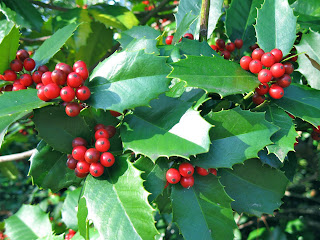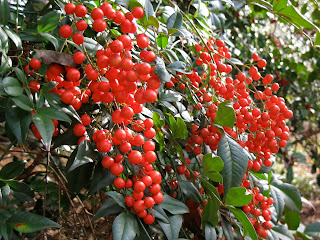It’s 2012, beginning of a brand new year, and time to make those annual resolutions. Sure, we all resolve to exercise more, eat healthier, use vices less - but how many of those do we actually want to do or keep? Here are my top 10 garden resolutions that I guarantee you will want to try and have no trouble keeping during the year!!!
Resolution No. 1 - Add mulch to all of your natural areas in January. Whether pine straw or bark nuggets, a fresh layer of mulch gives a clean, uniform appearance to your yard while protecting your plant’s precious roots. Just as humans appreciate warm footwear in the winter months, so do plants to insulate their feet!
Resolution No. 2 - Do you wish something was blooming in your garden right now? Here are some winter flowering plants to brighten the bleak winter days:
Lenten Roses (Hellebores orientalis) a shade loving perennial groundcover which blooms February through April in shades of cream, yellow, pink or purple. Seeds drop and self sow which results in more plants to enjoy or divide!
Camellia (japonica or sasanqua) evergreen shrubs which bloom from November through March depending on the species. My ‘ShiShiGashira’ Camellia started popping out eye-catching rosy pink flowers right before Thanksgiving and is still blooming on New Year’s Day!
Winter Jasmine (Jasminum nudiflorum) a beautiful vining shrub which is perfect to spill over walls or stabilize a sloped natural area. Will naturally root where stems touch the ground. Cheerful, yellow buds are a welcome winter sight in the new year!
Saucer Magnolia (Magnolia soulangeana) a deciduous magnolia which offers tulip shaped blooms in February and March.
Daffodil (Narcissus spp.) a bulb which greets us with fragrant, sunny blossoms in winter.
Resolution No. 3 - Consider adding a fragrant tree or shrub to your landscape. Winter is a great time to add this component to your garden so it can establish roots, begin growing this spring and offer a wonderful sense of smell in your yard!
Some of my favorites? Winter Honeysuckle (Lonicera fragrantissima) seen pictured below and Winter Daphne (Daphne odora), which are blooming RIGHT NOW and give off a sweet scent reminiscent of Froot Loops cereal.
Other wonderful choices are Gardenia jasminoides (shrub), Magnolia grandiflora (tree), and Confederate Jasmine (vine) seen pictured below.
Resolution No. 4 - Are you noticing and admiring all the beautiful lettuce, kale and cabbage mixed in with cool season annuals as seen in this gorgeous planter?
Wish you had some? Vow to have some of your own in 2012! While you can still find some in garden shops in January and is perfectly fine to try them now - circle the calendar for November 2012, because that is the best time to plant cool season annuals such as kale and cabbage alongside favorites such as parsley, snapdragons and pansies.
Resolution No. 5 - Wonder why some lawns are so lush and have very few weeds?
It is due to spreading pre-emergence which prevents weed seeds from germinating in the spring and taking hold in your yard. Several also have a light “feed” component - which will nourish your dormant grass during the winter. Try 2 applications of pre-emergence spaced 4-6 weeks apart. I plan to pre-emerge on January 15th and February 15th. In late March, my lawn will thank me.
Resolution No. 6 - Winter is an ideal time to thin or train deciduous shade trees. With the leaves off, it is easy to see which branches are bent, wayward or growing inappropriately and lop those suckers off! Look for stems that cross each other, are rubbing together or shoot upright from the branches. Remove those plus any split or broken branches that threaten to fall.
Then the dominant, healthy branches can grow in an appropriate manner and form a beautiful canopy.
Resolution No. 7 - Silver white winters that melt into spring. But why not add a plant which blooms white after winter? White flowers are classic and elegant and complement any color scheme or house style. Some of my choices are:
Iris spp.
“Snowball” Viburnum (Viburnum macrocephalum)
Spirea spp.
Oakleaf Hydrangea (Hydrangea quercifolia)
Resolution No. 8 - Take an inventory of your landscape and note bare spots and vacant areas. Resolve to try a new annual this spring when the time comes! In early May, after the threat of frost has passed, I plan to try these annuals:
Gomphrena, which is a “thriller” with fuchsia blooms on delicate, tall stems.
Portulaca, which is a heat and drought tolerant white blooming “filler”
and Cuban Oregano, which is a trailing, variegated vine which will “spill” over the edges of the planter.
These all love sun and heat, so they should be right at home in my front planters this spring through frost! All would equally do well in the ground in a mixed border.
Resolution No. 9 - Try growing your own herbs in your garden this spring to enjoy! Put them in a sunny to semi-sunny location whether in the ground or a pot! My top 3 herbs are:
Chives (Allium schoenoprasum) because they have beautiful rosy purple spring blooms atop grasslike foliage. Leaves can be snipped to add flavor to salads, cream cheese or anywhere a delicate onion flavor is desired.
Parsley (Petroselinum crispum), curly or flat leaved, which complements any border or container plant, has culinary use as a seasoning edible, doubles as a decorative garnish, and performs as a host plant for caterpillars ensuring a bevy of black swallowtail butterflies in your yard.
Rosemary (Rosmarinus officianalis) a fragrant, evergreen herb has many uses from baking to marinades. Tough, tolerant and a terrific addition to any garden!
Resolution No. 10 - Consider adding a native tree or shrub with a bountiful berry crop to your yard this year. Why use native plants? Because these plants presently or have historically existed in our ecosystem which means they have adapted to our local conditions. Those with berries also contribute to the maintenance of a healthy wildlife habitat by providing winter food! Which ones to try? Here are my top 3:
Possumhaw (Ilex decidua) - sheds its leaves in fall revealing brilliant, scarlet berries which cling to bare stems. Give this tall shrub (small tree) sun to partial shade and a male holly pollinator and you and the birds will enjoy this stunning plant all fall and winter.
Beautyberry (Callicarpa americana) - native woodland shrub with jaw-dropping clustered purple berries and yellow leaves in fall into winter.
Blueberries (Vaccinum spp.) Several are native and provide food for birds AND humans. Need at least two cultivars for cross pollination and fruiting. Beautiful fall color is another benefit.
I hope these suggestions will lead your garden and landscape to a happy, healthy 2012!
Check back in February when I will share my ideas for a native, natural landscape plan I have been working on for a client.














































